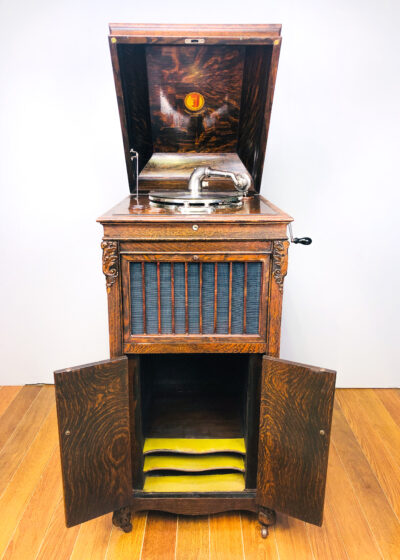Kimball Phonograph
The Kimball company, renowned for its high-quality pianos and organs, took its first foray into the world of sound reproduction in the early 1910s. Driven by a desire to offer a complete musical experience, Kimball saw the phonograph as an extension of its artistic expression. Unlike their competitors, who often mass-produced standardized models, Kimball embraced bespoke craftsmanship. Each phonograph was a meticulously handcrafted work of art, featuring intricate marquetry, polished hardwoods, and carefully calibrated sound systems.
Kimball’s early models, like the majestic Model T from 1917, reflected the grandeur of the Art Deco era. These imposing consoles, often reaching over five feet tall, served as statement pieces in opulent homes. Later models, like the sleek and versatile Model G from the late 1920s, embodied the Art Deco spirit of streamlining and functionality. Featuring elegant curves, chrome accents, and improved acoustics, these phonographs embodied the changing tastes of the times.
But the Kimball phonograph’s significance goes beyond aesthetics. From an historical perspective, they offered a unique alternative to the dominant players in the market. While Victor and Edison focused on standardization and cost-effectiveness, Kimball catered to a discerning clientele who valued both technological innovation and artistic refinement. Their meticulously crafted sound systems rivaled those of their competitors, ensuring rich, warm sounds that brought music to life.
Moreover, the Kimball phonograph represented a shift in the perception of recorded music. No longer simply a functional device, it became a treasured object, a centerpiece of the home, and a symbol of cultural refinement. Owning a Kimball was not just about listening to music; it was about experiencing the art of sound in its most exquisite form.
Despite their undeniable quality and charm, the Kimball phonograph remained a niche product. The company’s focus on bespoke craftsmanship and high-end finishes made them significantly more expensive than their mass-produced counterparts. As the Great Depression tightened its grip in the 1930s, even the wealthy turned towards more affordable options. Kimball ultimately ceased phonograph production in the late 1920s, leaving behind a legacy of stunning sound machines and a whisper of forgotten elegance.
Today, Kimball phonographs stand as silent testimonies to a bygone era, when recorded music was as much about artistry as it was about technology. They offer a glimpse into a world where craftsmanship reigned supreme, and beauty was woven into the very fabric of sound. As collectors meticulously restore these rare gems, the whispers of their stories begin to rise again, inviting us to rediscover the forgotten melody of the Kimball phonograph.
Showing the single result


